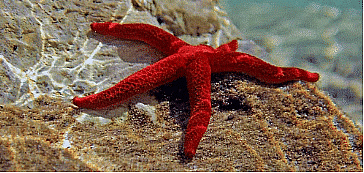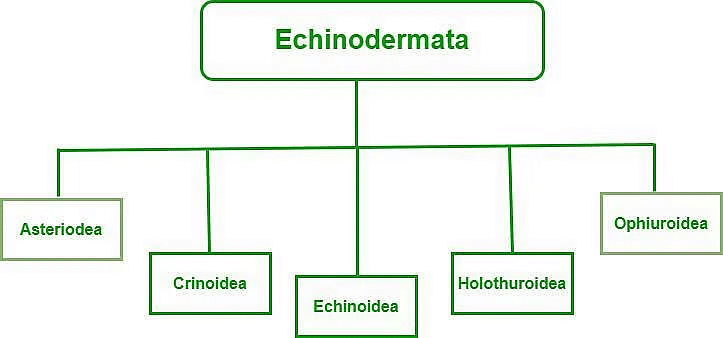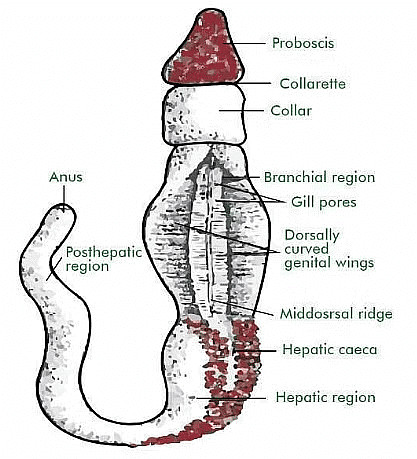Phyla - Echinodermata & Hemichordata | Biology for JAMB PDF Download
Phylum Echinodermata
Definition: Echinodermata, derived from the Greek words "Ekhinos" (spiny) and "derm" (skin), refers to marine animals characterized by their calciferous ossicles-based endoskeleton.
Characteristics:
- Echinoderms exhibit radial symmetry in their adult stage but start as bilaterally symmetrical larvae.
- With around 7000 species, Echinodermata ranks as the second largest phylum post-Chordata, predominantly comprising marine organisms.
- These creatures inhabit various oceanic regions, ranging from intertidal zones to the abyssal zone.
- Echinoderms such as Marine Stas, Sea Urchins, and Starfish are commonly found examples.
- Ecological Importance: Echinoderms play crucial roles both ecologically and geologically in marine ecosystems.
- Examples of Echinoderms:
Marine Stas
Sea Urchins
Starfish

Characteristics of Echinodermata
- Habitat: Echinoderms predominantly inhabit marine environments, often residing at the seafloor. They can either be sessile, meaning fixed in one place, or pelagic, indicating free-swimming.
- Body Structure: Echinoderms exhibit diverse body shapes, such as star-shaped (like starfish), cylindrical (as seen in sea cucumbers), or spherical (as in sea urchins). Notably, they lack a distinct head and are covered in spines.
- Symmetry: Adult echinoderms display radial symmetry, with body parts arranged in fives or multiples of five. In contrast, larvae exhibit bilateral symmetry.
- Body Cavity: Echinoderms possess a true coelom and are triploblastic, originating from three cell layers: Ectoderm, Mesoderm, and Endoderm.
- Epidermis: The epidermis of echinoderms is ciliated and single-layered, featuring hair-like projections (cilia) that aid in moving food particles towards the mouth and eliminating unwanted debris. Many species have protective spines for cleanliness.
- Digestive System: Echinoderms have a complete digestive system, including a ventrally located mouth and a dorsally located anus. However, brittle stars have an incomplete digestive system.
- Water Vascular System: Also referred to as the Ambulacral System, this unique system in echinoderms consists of tube feet that support locomotion, respiration, and the transport of food and waste.
- Excretory System: Echinoderms lack a distinct excretory system. Instead, their nitrogenous waste, like ammonia, diffuses out through respiratory surfaces such as tube feet.
- Sexes and Fertilization: Most echinoderms have separate sexes and reproduce sexually. Fertilization typically occurs externally, with larval development being indirect.
- Regeneration: Echinoderms, like starfish, exhibit regeneration, a process where they can regrow or replace lost body parts or organs.
- Locomotion: Echinoderms employ their tube feet for locomotion, showcasing indirect developmental patterns.
Classification of Echinodermata
The echinoderms belong to five sub-classes:

Asteroidea (Sea stars)
- Sea stars, known as Asteroidea, are typically mobile creatures that move using tube feet, which are small suction cups controlled by the water vascular system.
- They exhibit a flattened star-shaped body with five arms.
- While young sea stars display bilateral symmetry, adult sea stars have radial symmetry.
- Sea stars possess the remarkable ability to regenerate lost body parts.
- They feature Pedicellaria, a defensive claw-shaped appendage with movable valves, aiding in body cleaning by removing parasites and debris.
- Examples include Asterias and Zoroaster.
Crinoidea (sea lilies or feather stars)
- Crinoidea, also known as sea lilies or feather stars, exhibit radial symmetry.
- Their body structure resembles a cup with five or more bifurcated arms, each adorned with feathery projections called pinnules, housing reproductive organs and numerous tube feet without suckers.
- They lack Pedicellariae and spines.
- Some examples of Crinoidea are Articulata and Comatulida.
Echinoidea (sea urchins and sand dollars)
- Sea urchins and sand dollars exhibit radial symmetry.
- They possess an egg-shaped body that is hemispherical in shape.
- These creatures have skeletal plates adorned with numerous movable spines and 3-jawed pedicellariae for defense.
- While they feature tube feet for movement, they lack distinct arms for locomotion.
- Examples of Echinoidea include Sea Urchin, Echinus, and Cidaris.
Holothuroidea (sea cucumbers)
- Sea cucumbers, belonging to Holothuroidea, are characterized by their soft bodies and armless nature.
- They exhibit bilateral symmetry, unlike sea urchins.
- These organisms are elongated and cylindrical in shape, boasting tube feet equipped with suckers for mobility.
- Unlike sea urchins, they lack spines and pedicellariae for protection.
- Notable examples of Holothuroidea include Holothurian and Royal Cucumber.
Ophiuroidea (brittle stars and basket stars)
- Ophiuroidea creatures showcase pentaradial symmetry in their body structure.
- Their tube feet lack suckers, distinguishing them from sea cucumbers and sea urchins.
- Respiration in Ophiuroidea species occurs through specialized structures called Bursae.
- They possess an internal skeleton made of calcium carbonate, providing structural support.
- Examples of Ophiuroidea include Euryalida and Ophiurida.
Examples of Echinodermata
- Starfish
- Sea Urchin
- Brittle Stars
- Sand Dollars
Significances of Echinodermata
As Food
- Echinoderms have been traditionally harvested as a food source. Sea Cucumber and Sea Urchins are particularly popular, with Sea Cucumber being utilized in gelatinous soups in China, while the gonads of Sea Urchin are consumed in Japan and France.
As Medicine
- Sea Urchins and Sea Cucumbers not only serve as seafood but also find applications in traditional Chinese medicine for various medical purposes.
In Research
Sea Urchins, especially due to their robust larvae, are extensively employed in research settings, particularly in developmental biology and embryological studies.
- Sea Urchin sperm is extensively used in the study of fertilization processes.
- The arm of Brittle Star is a valuable subject for research into neurodegenerative disorders.
Other Uses
- Echinoderms with calcareous shells are utilized as a source of lime by farmers.
- Starfish serve as a crucial food source for various organisms.
- Additionally, Starfish are employed either as dried specimens or as artistic representations.
Phylum Hemichordata
- Distinct structures and forms characterize various animals. Classification is crucial due to the introduction of numerous animal species, aiding in providing a systematic position for newly discovered organisms.
- Animals exhibit specific shapes and sizes, typically unbranched except for sponges. Their organs, like liver, heart, kidney, lungs, brain, and stomach, are mainly internal.
- An animal's body growth is finite, ceasing long before death. Growth regions lack localization, allowing movement from one place to another. Animals possess sense organs, nervous systems, and excretory organs.
- Major animal phyla include Porifera, Cnidaria, Ctenophora, Platyhelminthes, Nematode, Annelida, Arthropoda, Mollusca, Echinodermata, Hemichordata, and Chordata.
Overview of Phylum Hemichordata
- Hemichordates are marine organisms displaying characteristics common to both invertebrates and vertebrates.
- They exhibit a body structure with three parts: proboscis, collar, and trunk, resembling the head, neck, and trunk of vertebrates.
- For example, acorn worms are a well-known group within Hemichordata, showcasing these distinct body regions.
Hemichordata

- Hemichordates share similarities with chordates, leading some to initially consider them a subphylum of Chordata. However, recent scientists like Van der Horst, Dawydoff, Marcus, and Hyman have classified them as an independent invertebrate phylum. The name "Hemichordata" is retained for this group.
- The Tornaria larva of Balanoglossus was first identified by J. Muller.
Distinguishing Features of Hemichordata
- Hemichordates are predominantly tubiculous creatures that inhabit burrows and are found exclusively in marine environments.
- Their body structure resembles a worm, segmented into proboscis, collar, and trunk.
- They possess a body wall with a single-layered epidermis.
- Hemichordates are enterococcus organisms.
- Stomochord, a hollow protuberance, emerges from the roof of the buccal cavity known as the 'buccal diverticulum' and is located in the proboscis.
- They have a complete digestive tract.
- When present, hemichordates exhibit one to several pairs of gill slits, which are dorsal in position for respiration through the gills.
- Their blood vascular system is open-type, typically featuring a contractile heart vesicle, two longitudinal vessels (dorsal and ventral), lateral vessels, and sinuses. Their blood is colorless.
- The excretory organ is a single glomerulus situated in the proboscis, known as the proboscis gland.
- The primary nervous system consists mainly of an intra-epidermal nerve plexus.
- Sensory cells distributed in the epidermis function as sense organs.
- They exhibit separate sexes with mostly sexual reproduction; gonads vary from one to multiple pairs, and fertilization is typically external.
- With the exception of certain species, their development is predominantly indirect, involving a free-swimming tornaria larva.
Classification of Hemichordata
Phylum Hemichordata is categorized into four classes:
Enteropneusta
- This class comprises acorn worms, characterized by a vermiform body, typically found on sandy beaches near warm seas. There are approximately 70 species within this class. They are commonly referred to as acorn worms due to their distinctive proboscis and collar appearance.
Pterobranchia
- Pterobranchia members inhabit deep sea waters and exhibit tube-dwelling behavior. They rely on attaching to other organisms for survival, particularly as they are bottom dwellers. This class encompasses around 20 species.
Order 1: Cephalodiscida
Characterized by single paired gill slits and single-paired gonads, individuals of this order reside independently within a communal jelly-like structure. Examples include Cephalodiscus and Atubaria.
Hemichordates:
- Hemichordates are marine deuterostomes with a unique body plan.
- They possess single paired gill slits for respiration.
- Reproductive organs, known as gonads, are also single-paired.
- Some species exhibit a peculiar lifestyle where several individuals coexist in a common jelly-like house.
- Examples: Two notable examples are Cephalodiscus and Atubaria.
Order 2: Rhabdopleurida
This order includes organisms with distinct characteristics:
- A single gonad is present for reproductive purposes.
- Gill slits facilitate respiration.
- These creatures lead a colonial lifestyle, with zooids connected via stolons.
- Example: Rhabdopleura, the sole genus within this order.
Planctosphaeroidea
- Planctosphaeroidea is a group primarily identified through floating larvae.
- Key features of this group include:
An L-shaped alimentary canal for digestion.
Larval bodies are adorned with extensively branched ciliary bands.
Graptolita
- Graptolites are extinct colonial hemichordates renowned for their tube-like structures.
- Distinct characteristics of Graptolites:
- Each animal resides within a zooid structure.
- Abundant during the Ordovician and Silurian periods.
- Example: Dendrograptus, a well-known representative of this group.
Examples
Balanoglossus (acorn or tongue worm), Saccoglossus (very much similar to Balanoglossus in habits, habitat, and structure), Cephalodiscus.
Balanoglossus
- Balanoglossus is an ocean-dwelling acorn worm genus with great zoological importance as it serves as an evolutionary link between invertebrates and vertebrates.
- As a Hemichordate, Balanoglossus is classified as a deuterostome and shares similarities with Ascidians or sea squirts, possessing branchial openings known as "gill slits."
- It features a notochord located in the upper part of its body and lacks a nerve cord, although it does possess a stomochord, a gut cord enclosed by the collar.
- The size of Balanoglossus heads can range from as small as 2.5 mm (1/10 in) to as large as 5 mm (1/5 in).
Saccoglossus
- Saccoglossus belongs to a group of marine animals known as acorn worms.
- It is the most extensive genus within this category, comprising a total of 18 different species.
- One distinctive feature of Saccoglossus is the presence of circular muscle layers in its proboscis.
- These creatures are commonly found in habitats such as coastal mud and sandy areas, often in close proximity to bays.
Why Hemichordates are not placed under Chordates?
- Hemichordates do not possess a notochord or a post-anal tail, which are distinguishing characteristics of chordates. Initially, they were classified among chordates; however, due to the absence of any form of backbone or chord, they were excluded from the group.
- Hemichordates, also known as acorn worms, are marine animals with triploblastic bodies.
|
225 videos|175 docs|156 tests
|
FAQs on Phyla - Echinodermata & Hemichordata - Biology for JAMB
| 1. What are the key characteristics of Echinodermata? |  |
| 2. How are Echinodermata classified? |  |
| 3. What are the significances of Echinodermata in the ecosystem? |  |
| 4. What are the distinguishing features of Hemichordata? |  |
| 5. How is Phylum Hemichordata classified? |  |





















